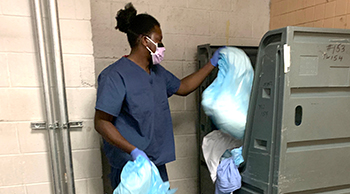
Popular Locations
- Yale New Haven Children's Hospital
- Yale New Haven Hospital - York Street Campus
- Yale New Haven Hospital - Saint Raphael Campus


Unitex linen attendant Fred Chisolm recently loaded a cart with soiled linen at the York Street Campus. The linen will be brought to Unitex, Yale New Haven Health’s linen vendor, for cleaning and disinfecting. Staff should put all used linen in the soiled linen containers on each unit. All linen can be cleaned, regardless of how dirty it is, and should never be put in the trash.
In a hospital setting, where staff rely on sterile materials and disinfecting agents to reduce infection risk, how should healthcare workers deal with dirty linens?
Don’t throw them away!
Every piece of linen can be cleaned, no matter how soiled or even blood-soaked it is, said Rachel Handel, an outsourced services coordinator with Yale New Haven Health’s Corporate Supply Chain. All used linens should be put in the soiled linen containers, including those used for patients with infectious diseases such as COVID-19, C. diff, MRSA or monkeypox.
“The health system’s linen vendor, Unitex, specializes in cleaning processes that meet infection-prevention standards,” Handel said.
Linens include bed sheets, pillowcases, blankets, underpads, towels, patient gowns, scrubs, lab coats, curtains and mops. While many medical supplies are designed for one-time use, hospital linens are reusable.
“When people toss linen in the trash, it’s like throwing money away,” Handel said, explaining that the health system gets its linen supply through a rental company. “Our linen rental program charges us for what’s ordered each week. When the soiled linens aren’t returned, we pay more to replace those that end up in the trash, along with those that are being hoarded in closets or blanket warmers.”
As an example, Handel said, it costs about 46 cents to rent a hospital bed sheet, but $3.91 to replace one that’s thrown away or missing from the inventory. Handel and her colleagues calculated that YNHHS – across all settings – uses 14 million pounds of linen each year. They found that thousands of pounds end up in the trash each week, which has contributed to an additional $863,000 in linen replacement costs this year alone.
Another seemingly harmless habit adds to rising replacement fees.
“Clean linen should be brought into the patient’s room only as needed,” Handel said. “If you bring three blankets into the room when the patient needs just one, you’re wasting the clean linen. Even if this linen is not used, it must go into the soiled linen when the patient is discharged.”
What if you find a clean linen item that is damaged? Don’t throw that away, either. Place it in the designated rejected linen bag (every unit has one). Your department will get credit for any rejected items, and the plant will replace them with new ones, Handel said.
If you have questions about the linen rental program, contact Handel at [email protected].